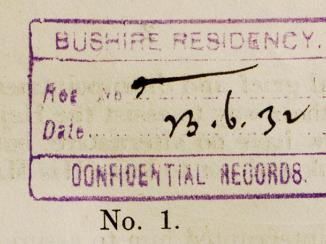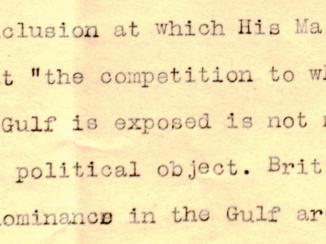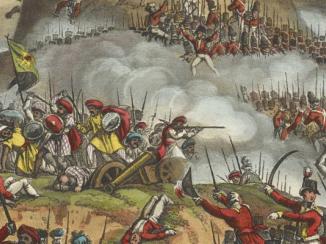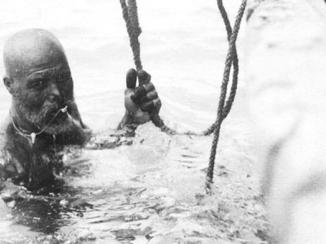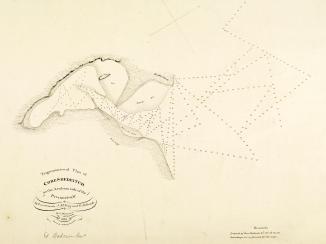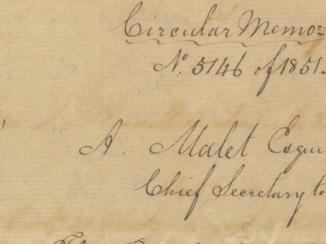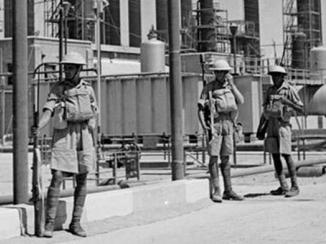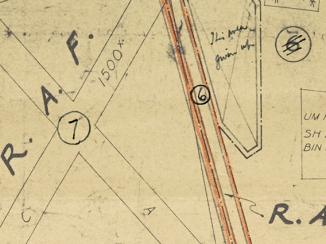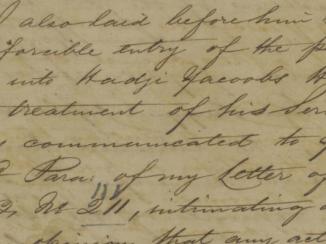Overview
What is the Persia Collection?
The Persia Collection (collection number 28) is part of the Political (External) Department Records within the L/PS/12 Series of the India Office The department of the British Government to which the Government of India reported between 1858 and 1947. The successor to the Court of Directors. Records. The collection focuses on Britain’s interests in Iran through the 1930s and into the late 1940s. In spite of the Persian Government changing the name of their country to Iran in 1935, British officials continued to refer to the country as Persia in their correspondence. In total, the Persia Collection consists of 166 loose files and bound volumes, totalling in excess of 31,000 folios.
What types of records will you find?
The Persia Collection consists largely of correspondence in the form of letters and telegrams, along with memoranda, reports, minutes, legal documents, and maps. Much of the material was classified as Secret, with particularly sensitive material marked as Most Secret.
The correspondence was chiefly exchanged between staff at the British Legation in Tehran (Britain’s main political office in Iran), and the India Office The department of the British Government to which the Government of India reported between 1858 and 1947. The successor to the Court of Directors. , Foreign Office, and the Government of India. In diplomatic terms, Britain did not enjoy ambassadorial status in Iran until 1946. Prior to that, Britain’s senior political representative in Tehran was the Envoy Extraordinary and Minister Plenipotentiary A diplomatic representative who ranks below an ambassador. The term can be shortened to 'envoy'. . During the summer months, the British Legation often sent correspondence from its residence in Gholhak Gardens, outside the city. Other correspondents from the British Legation included the Counsellor at the Legation and the Military Attaché.
Aside from communications between British Government departments, the Persia Collection also contains correspondence sent to the British Legation from other parties, including: the Government of Iran, most notably the Minister or Ministry of Foreign Affairs; the Anglo-Persian Oil Company (later BP); and Imperial and International Communications Limited, which was responsible for the operation and maintenance of British telegraph cables in Iran.

A large proportion of the Persia Collection consists of compilations of consular diaries, commercial diaries, and intelligence summaries, submitted by British consular representatives posted to various provinces in Iran. The British had diplomatic representation across the country, with consulates or vice-consulates in Isfahan, Meshed [Mashhad], Ahwaz [Ahvāz], Kerman, Kermanshah, Mohammerah [Khorramshahr], Seistan [Sīstān], and Tabriz.
These reports were generally submitted to the British Legation on a monthly basis by a Consul or Vice-Consul, although many reports were submitted on a fortnightly basis during the Second World War. Unlike other files in the Persia Collection, which are ordered with the earliest correspondence at the rear of the file and the latest at the front, many of these files are ordered with the earliest reports at the front of the file and the latest at the rear.

What subjects are covered by in the Persia Collection?
Files in the Persia Collection fall broadly into one of two categories: those from the 1930s before the Second World War, and those from 1939-1949 both during and immediately after the War. Files prior to the War chiefly concern: the Shah of Iran’s programme for modernisation of Iranian government and society along European lines; Iranian trade; Persian railways, with much attention given to the Mirjawa to Zahidan railway on the Baluchistan border; the transfer of the Iranian section of the Indo-European Telegraph Department to the Iranian Government; the frontier between Iran and British Baluchistan; matters relating to the Anglo-Persian Oil Company; and relations between the Iranian and British Governments.

Files dating from the Second World War chiefly relate to the Anglo-Soviet invasion and subsequent occupation of Iran between 1941 and 1946. During these years, Britain occupied the southern, and the Soviet Union the northern provinces of the country. The occupation was intended to put a stop to Iran’s trade with Germany, secure Allied access to Iranian oil fields, and ensure the maintenance of the Allies’ supply lines to the Soviet Union during the War. These files concern: Iran’s financial administration during the occupation, overseen by the American Arthur Chester Millspaugh; Soviet and British propaganda; and deteriorating political and social conditions across Iran after the war, with particular reference to British concern over growing Soviet influence in northern Iran, culminating in the Azerbaijan crisis of 1946.
Gaps in the Collection
There are a few gaps on the Qatar Digital Library in the run of files between IOR/L/PS/12/3390 and IOR/L/PS/12/3550. There is one non-existent or missing file (IOR/L/PS/12/3393), and one empty file (IOR/L/PS/12/3498), while two others (IOR/L/PS/3461 and IOR/L/PS/12/3545) chiefly comprise newspaper cuttings, and have therefore not been digitised due to copyright restrictions.
In summary, the Persia Collection files are an invaluable resource for students and researchers interested in Britain’s historic relationship with Iran in the early twentieth century, and Britain’s role in the occupation of the country during the Second World War.


